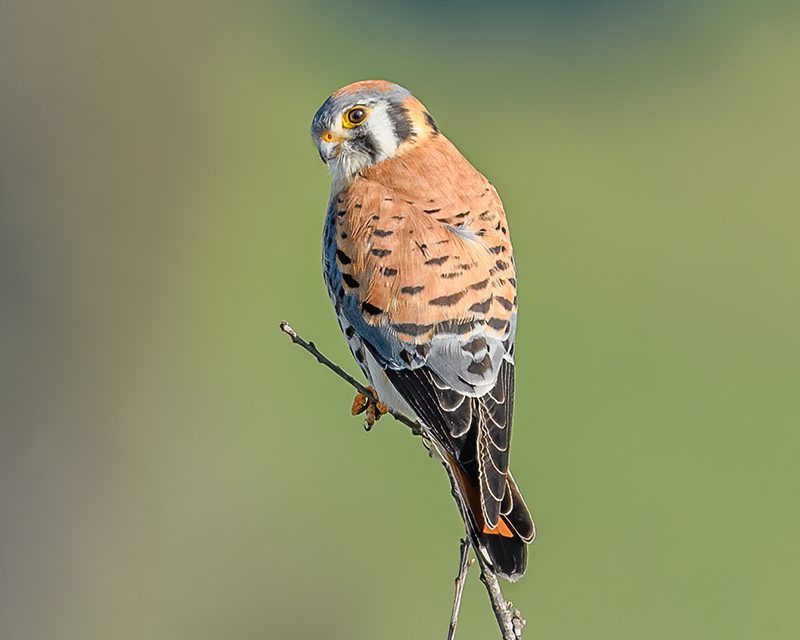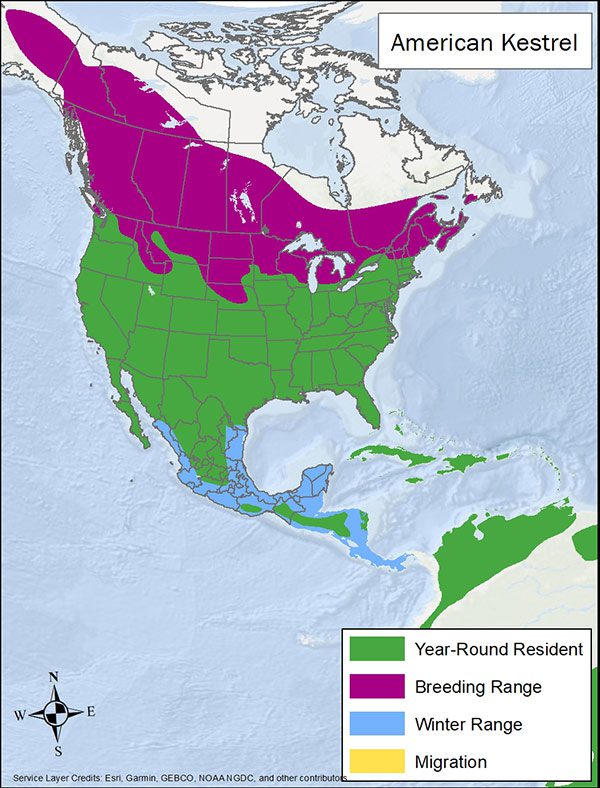LandPKS Learning
Habitat Hub

American Kestrel
Kestrels hide surplus prey in grass clumps, tree roots, bushes, fence posts, tree limbs, and cavities, to save the food for lean times or to hide it from thieves. In winter in many southern parts of the range, female and males use different habitats. Females use the typical open habitat, and males use areas with more trees. This situation appears to be the result of the females migrating south first and establishing winter territories, leaving males to the more wooded areas.
Falco sparverius
Identification
American kestrels are the smallest raptor and more closely related to other falcons such has peregrine and prairie falcon and about the size of a mourning dove at 8-12 in/22-31 cm long. In flight, the wings are often bent and the wingtips swept back. It’s a rather colorful raptor with distinct blue/gray on the wings with a reddish body, speckled by black dots. A notable characteristic are its two black facial strips down its cheeks.
Observation Tips
American kestrels are a common widespread falcon. Some birds breed in the northern parts of the U.S. and Canada and winter in eastern Mexico/Central America; however, kestrels are mostly year-round residents throughout much of their range. To look for them, scan fence posts, utility lines and telephone poles, particularly when driving through farmland. In September or early October, catch them by the hundreds at coastal migration sites such as Cape May, New Jersey, or Kiptopeke, Virginia. They will nest in a cavity in a tree or in nest boxes.
Interesting Fact
Kestrels hide surplus prey in grass clumps, tree roots, bushes, fence posts, tree limbs, and cavities, to save the food for lean times or to hide it from thieves. In winter in many southern parts of the range, female and males use different habitats. Females use the typical open habitat, and males use areas with more trees. This situation appears to be the result of the females migrating south first and establishing winter territories, leaving males to the more wooded areas.
Ideal Habitat
Kestrels prefer a wide variety of open to semi-open habitats, including meadows, grasslands, deserts, agricultural fields, and both urban and suburban areas, regardless of dominant vegetation. Breeding territories characterized by either large or small patches covered by short vegetation, with taller woody vegetation either sparsely distributed or lacking altogether, <5%. Perches are required, either trees, fence posts, or utility poles. Typical breeding habitat consists of large, >61 ac/25 ha, pasture or recently fallowed field, with one or few isolated large dead trees for nesting and several potential perches, and dense herbaceous cover >70%.

Range map provided by BirdLife International
Management Activities that Benefit Species – Best Management Practices (BMPs)
Maintain semi-open short-structured, dense grasslands and meadows with perching trees or fence posts/utility poles.
Management Activities to Avoid
The primary activities to avoid are not be management oriented, but more related to human activities. Avoid conversion of native grasslands to cropland and residential development. Avoid pesticides that can remove prey available for kestrels. Avoid removing all trees in a landscape as kestrels nest in tree cavities.
Other Species that Benefit from Similar Habitat Management
Other wildlife that may benefit from habitat management for American kestrels include golden eagles, ferruginous and Swainson’s hawks, pronghorn antelope and prairie falcon.
Download
Download the American Kestrel factsheet
Other Resources
BirdLife International and Handbook of the Birds of the World. 2019. Bird species distribution maps of the world. Version 2019.1. American Kestrel
The Cornell Lab of Ornithology. Birds of the World (American kestrel).
The Cornell Lab of Ornithology. All About Birds (American kestrel).
NatureServe. 2019. NatureServe Explorer: An online encyclopedia of life [web application]. Version 7.1. NatureServe, Arlington, Virginia. American kestrel
Photo credit: Becky Matsubara/Flickr
Mobile App | Data Portal | Knowledge Hub | Habitat Hub | Learning Collections | Blog | About | Contact | Support



